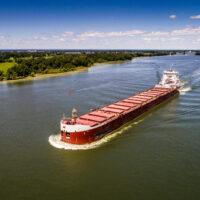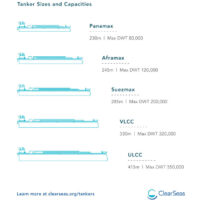This independent review of their operations does much to shine a light on the strengths and weaknesses of Canada’s current ship-based oil spill response capacity.
Executive Summary
Clear Seas is an independent, not-for-profit organization that provides impartial and evidence-based research to inform the public and policy makers about marine shipping in Canada.
Accordingly, we are providing this digest of the Independent Review of the M/V Marathassa Fuel Oil Spill Environmental Response Operation. The Review was conducted with the objective of improving the overall oil spill response regime for the Canadian Coast Guard, its partners and Canadians. Its findings were completed and presented to the Coast Guard Commissioner in July of 2015.
This short digest is not meant to be inclusive of all the Review’s commentary and/or recommendations, nor are the items mentioned necessarily in the same order as the original report.
Message from the Executive Director
The Canadian Coast Guard receives many pollution reports each year. In its Western Region, which encompasses the entire coast of British Columbia, it receives about 600 such reports annually, approximately 40 of which occur in the Port of Vancouver, and about 10 require some form of on-water recovery. The Coast Guard and the Western Canada Marine Response Organization address such spills as part of their operational mandate.
The M/V Marathassa incident requiring on-water recovery and clean-up in April 2015 was a relatively atypical event for both these organizations. This independent review of their operations does much to shine a light on the strengths and weaknesses of Canada’s current ship-based oil spill response capacity.
From Clear Seas’ perspective, any oil or fuel spill, no matter how small, is one too many. We hope this short digest will encourage all those interested in the subject of marine safety to read the entire report to ascertain for themselves the pluses and minuses of our current response regime, and where improvements are needed.
Background
Early on the morning of April 6, 2015 the bulk grain carrier M/V Marathassa entered Vancouver waters and proceeded to anchorage in English Bay. It was transiting in ballast -meaning without cargo. In the late afternoon of April 8, 2015, the CCG’s Marine Communications Traffic Services (MCTS) received the first report of a mystery fuel oil spill sheen in the water close to this vessel.
The spill triggered investigations and clean-up operations by a myriad of federal, provincial and local marine spill response organizations which, in the case of English Bay, included: the Canadian Coast Guard (CCG), Transport Canada (TC), Environment Canada (EC), the Western Canada Marine Response Corporation (WCMRC), and Port Metro Vancouver (PMV), among others.
While CCG has ultimate responsibility for ship-source and mystery-source spills in Canadian waters, a Letter of Understanding (LOU) between PMV and CCG provides further clarification on responsibilities in the port. It indicates that the port will collect information in order to conduct an initial assessment. If a spill is determined to be recoverable, the CCG will assume command and control.
Although the Captain and representatives for the M/V Marathassa initially denied responsibility, it was subsequently determined that it had indeed discharged an unknown quantity of intermediate fuel oil (suspected to be IFO 380) into English Bay on April 8.
The operational fuel oil spill clean-up was successfully executed by the WCMRC under the direction of the CCG. WCMRC skimmed fuel oil off the water throughout the night of April 8 and surrounded the vessel with a containment boom on Thursday, April 9, to prevent further pollution damage. On the morning of the same day, it was estimated that approximately 2800L of intermediate fuel oil remained on the water, and by the afternoon of April 10, 5.9L remained. From initial response – to completion of operations – lasted 16 days. There was minimal impact on the public from a health and safety perspective; however, Environment Canada (EC) estimated that approximately 20 birds were affected.
There are 25 recommendations identified in this report for the CCG and stakeholder partners’ consideration. This digest will concentrate on those recommendations that have national implications, rather than those that are specific to the Port of Vancouver.
As indicated above, the operational oil spill clean-up from English Bay waters was succsessfully executed by the WCMRC under the direction of the CCG – in relatively short order. WCMRC took a proactive posture early on in the incident, and as a result was able to respond swiftly.
For its part the CCG used an inclusive approach to the Unified Command[1] structure, bringing in other levels of government and non-governmental organizations, which was seen in a positive light by most and as the the response progressed, Unified Command, under CCG leadership, became increasingly coordinated.
Provincial and municipal partners, and WCMRC are well versed in the Incident Command System (ICS)[2] and have offered to exercise and assist the CCG in its implementation of ICS; and also welcomed the opportunity to participate in meaningful engagement on ways to improve oil spill response and are prepared to continue to build these relationships.
But not everything went smoothly. There appeared to be confusion among some partners regarding the roles and responsibilities of key players in the oil spill response.
The Review also noted that the CCG should improve its protocols with partners to ensure accuracy and timeliness of communications. A combination of factors such as uncertainty of roles and responsibilities, miscommunications, and technical difficulties, resulted in a delay in the initial response of 1 hour and 49 minutes.
Furthermore, CCG did not have the initial capacity to stand up the Incident Command Post (ICP) and Unified Command as they were demobilizing their Pollution Response Officers from another operation. The CCG therefore contracted WCMRC to initiate the on-water response and provide ICP support.
Information sharing on a common network was not possible due to Government of Canada electronic policies and protocols, which limited the effectiveness of the ICP.
Early alerting of the municipalities, First Nations, and stakeholders of the incident was delayed due to the low classification of the incident in the provincial alerting system. Some partners were notified of the event via informal channels due to previous working relationships or were alerted by the heightened media attention.
The lack of a physical presence of Environment Canada impacted the effectiveness and efficiency of the Environmental Unit in responding to the incident. Environment Canada’s on-site leadership in providing sound, independent scientific and environmental advice would have been greatly beneficial to this incident.
Inasmuch as many of the deficiencies in the response came about as a result of misunderstandings, miscommunications and technical difficulties the Review offered a number of recommendations[3] including:
- Ensuring the Coast Guard has adequate staff to respond to a major marine pollution incident in any part of its region at any given time;
- Reviewing its National Incident Notification Procedure criteria to ensure all significant incidents receive verbal notification 24/7 to the senior national leadership of CCG;
- Continuing implementation of the Incident Command System, including exercises with all partners, First Nations, provincial and municipal partners, and non-governmental organizations as part of the plan;
- Developing simplified quick reference tools for Incident Command Post members who are not familiar with the roles and responsibilities of Incident Command positions;
- Ensuring roles are rapidly assigned and explained to members who join the Incident Command Post;
- Ensuring accurate information is released by Unified Command and/or Incident Command as soon as possible regarding the type, quantity, and fate and effects of a pollutant, including any information that is related to public health concerns;
- Developing an accelerated regional approval process with respect to factual operational information during an incident, similar to the current procedures for sharing information in Search and Rescue incidents;
- Developing a rapidly deployable communications and IT system that facilitates a more effective and timely electronic interface with partner agencies during an incident. In addition,
- Environment Canada should review its trigger criteria for on-site presence, in collaboration with CCG, particularly in complex incidents.
In its concluding remarks the Review noted that “…this was an operational discharge of persistent fuel oil with very high consequences. While it is certainly positive that Canada has a robust oil spill response regime, the Canadian Coast Guard and its partners rarely respond to real life events due to the infrequency of persistent oil spill events in Canadian waters.
The CCG and its oil spill response partners need to actively engage in the development of localized area response plans[4] They also need to engage in exercises, both large and small, to test the system and to establish and maintain relationships. Exercising the area response plans and the Incident Command System are instrumental for a successful outcome when the real event occurs.”
[1] Unified command is an important aspect of the Incident Command System (ICS), which allows governments and companies to work well together.
[2] ICS is an incident management methodology used to structure and organize on-scene incident response. It provides a flexible and scalable command, control and coordination structure that is applicable to incidents of any type, scope, and complexity.
[3] On April 7, 2015 the Canadian Coast Guard Released an update on its progress to date on acting on the report’s recommendations. Independent Review of the M/V Marathassa Fuel Oil Spill Environmental Response Operation. Chapter 3 – Observations, Analysis and Recommendations
[4] Further information on the current status of Government of Canada’s Area Response Planning Initiative can be found at https://www.tc.gc.ca/eng/marinesafety/oep-ers-arp-4473.html.



